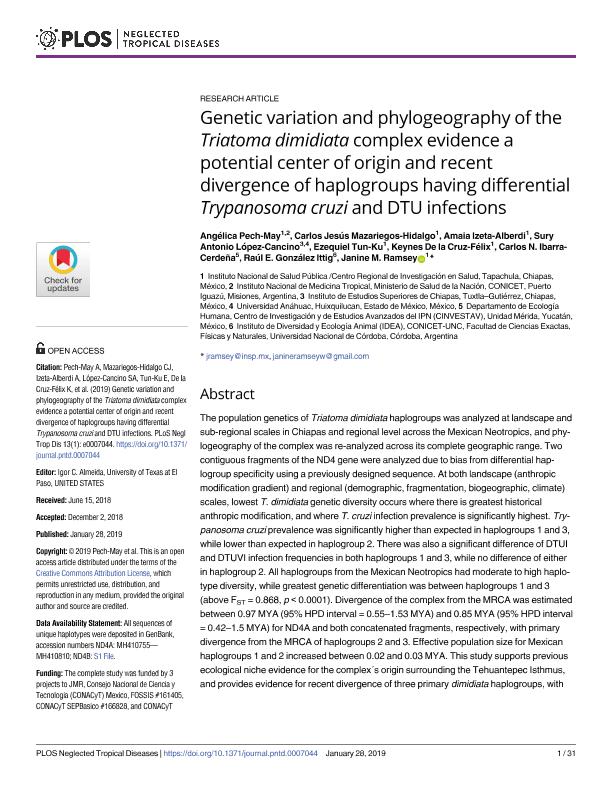Artículo
Genetic variation and phylogeography of the Triatoma dimidiata complex evidence a potential center of origin and recent divergence of haplogroups having differential Trypanosoma cruzi and DTU infections
Pech May, Angélica del Rosario ; Mazariegos Hidalgo, Carlos Jesús; Izeta Alberdi Amaia; López Cancino, Sury Antonio; Tun Ku, Ezequiel; De la Cruz Félix, Keynes; Ibarra Cerdeña, Carlos; González Ittig, Raúl Enrique
; Mazariegos Hidalgo, Carlos Jesús; Izeta Alberdi Amaia; López Cancino, Sury Antonio; Tun Ku, Ezequiel; De la Cruz Félix, Keynes; Ibarra Cerdeña, Carlos; González Ittig, Raúl Enrique ; Ramsey, Janine
; Ramsey, Janine
 ; Mazariegos Hidalgo, Carlos Jesús; Izeta Alberdi Amaia; López Cancino, Sury Antonio; Tun Ku, Ezequiel; De la Cruz Félix, Keynes; Ibarra Cerdeña, Carlos; González Ittig, Raúl Enrique
; Mazariegos Hidalgo, Carlos Jesús; Izeta Alberdi Amaia; López Cancino, Sury Antonio; Tun Ku, Ezequiel; De la Cruz Félix, Keynes; Ibarra Cerdeña, Carlos; González Ittig, Raúl Enrique ; Ramsey, Janine
; Ramsey, Janine
Fecha de publicación:
28/01/2019
Editorial:
Public Library of Science
Revista:
PLoS Neglected Tropical Diseases
ISSN:
1935-2735
Idioma:
Inglés
Tipo de recurso:
Artículo publicado
Clasificación temática:
Resumen
The population genetics of Triatoma dimidiata haplogroups was analyzed at landscape and sub-regional scales in Chiapas and regional level across the Mexican Neotropics, and phylogeography of the complex was re-analyzed across its complete geographic range. Two contiguous fragments of the ND4 gene were analyzed due to bias from differential haplogroup specificity using a previously designed sequence. At both landscape (anthropic modification gradient) and regional (demographic, fragmentation, biogeographic, climate) scales, lowest T. dimidiata genetic diversity occurs where there is greatest historical anthropic modification, and where T. cruzi infection prevalence is significantly highest. Trypanosoma cruzi prevalence was significantly higher than expected in haplogroups 1 and 3, while lower than expected in haplogroup 2. There was also a significant difference of DTUI and DTUVI infection frequencies in both haplogroups 1 and 3, while no difference of either in haplogroup 2. All haplogroups from the Mexican Neotropics had moderate to high haplotype diversity, while greatest genetic differentiation was between haplogroups 1 and 3 (above F ST = 0.868, p < 0.0001). Divergence of the complex from the MRCA was estimated between 0.97 MYA (95% HPD interval = 0.55-1.53 MYA) and 0.85 MYA (95% HPD interval = 0.42-1.5 MYA) for ND4A and both concatenated fragments, respectively, with primary divergence from the MRCA of haplogroups 2 and 3. Effective population size for Mexican haplogroups 1 and 2 increased between 0.02 and 0.03 MYA. This study supports previous ecological niche evidence for the complex´s origin surrounding the Tehuantepec Isthmus, and provides evidence for recent divergence of three primary dimidiata haplogroups, with differential T. cruzi infection frequency and DTU specificity, important components of vector capacity.
Palabras clave:
Triatoma dimidiata
,
Trypanosoma cruzi
,
Phylogeography
,
Population genetics
Archivos asociados
Licencia
Identificadores
Colecciones
Articulos(IDEA)
Articulos de INSTITUTO DE DIVERSIDAD Y ECOLOGIA ANIMAL
Articulos de INSTITUTO DE DIVERSIDAD Y ECOLOGIA ANIMAL
Citación
Pech May, Angélica del Rosario; Mazariegos Hidalgo, Carlos Jesús; Izeta Alberdi Amaia; López Cancino, Sury Antonio; Tun Ku, Ezequiel; et al.; Genetic variation and phylogeography of the Triatoma dimidiata complex evidence a potential center of origin and recent divergence of haplogroups having differential Trypanosoma cruzi and DTU infections; Public Library of Science; PLoS Neglected Tropical Diseases; 13; 1; 28-1-2019; 1-31
Compartir
Altmétricas



